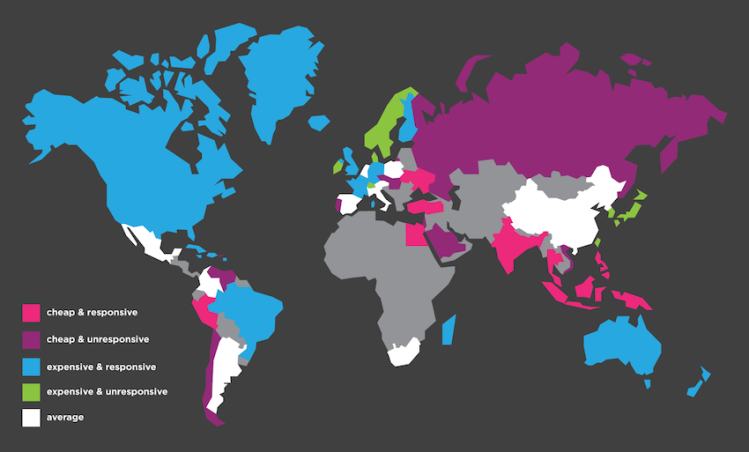Mobile marketers, forget about countries.
According to mobile marketing agency Fetch’s new report, “Agile Planning for a Mobile World,” the key to mobile advertising is thinking of your targeted users by their behavior instead of their geography.
The result, covering ads for both mobile web and apps, can create some odd groupings. Australia and Finland, for instance, are plotted next to each other in a graph of user acquisition versus user responsiveness.
The former includes cost-per-click (mobile web) and the cost of getting someone to install an app. The latter is the clickthrough rate (mobile web) and the click-to-install rate. In those two countries, users are expensive to reach but responsive to ads.
Advertisers can “achieve more effective campaign results by positioning ad content around countries’ mobile behavior rather than geographic location,” the report says. It’s based on millions of data points registered in the agency’s FetchMe data dashboard, designed to track user behaviors like app installs against ad buys.
So, mobile advertising markets no longer look like this:
Instead, they look like the map at the top of this page.
Many mobile marketers already employ user behavior in their campaigns, especially within countries. But, report author and Fetch head of data Dan Wilson told me, “The prioritization level is typically by country.”
That is, marketers — even when their campaigns use behavior targeting — tend to think about budget and focus in terms of geographical regions. Marketers need to get their budgets and campaigns in sync, he said.
When grouped in the report’s fashion, Sweden, Norway, Ireland, Japan, South Korea, and the U.S. are expensive to reach and hard to engage. Australia, New Zealand, Finland, and the U.K., on the other hand, are expensive to reach but have responsive users.
VentureBeat is studying marketing analytics tools…
Chime in, and we’ll share the data with you.
Germany, Turkey, Thailand, India, and Ukraine are among the countries that are both relatively inexpensive to acquire and easy to engage, while Vietnam, the Czech Republic, Hungary, and Israel are less developed mobile markets — cheaper to acquire but not very engaged.
So, forget EMEA, North America, and Latin America. The key regions are Cheap & Responsive, Cheap & Unresponsive, Expensive & Responsive, Expensive & Unresponsive, and Average.
“Your optimization strategy in Canada may work very well in Brazil but not necessarily in Russia,” the report notes.
Generally speaking, Wilson said that “countries where users are expensive to acquire have higher smartphone penetration and likely have more expendable income,” making them valuable to advertisers. Behaviors, he added, are driven by the number of high-end devices in a market and “the comfortableness of the population” in responding to ads.
The report looked largely at banner ads, including rich media ones, in part because it was the easiest to compare across markets.
(Disclosure: Fetch owns a less-than-0.5 percent stake in VentureBeat.)
VentureBeat's mission is to be a digital town square for technical decision-makers to gain knowledge about transformative enterprise technology and transact. Learn More


